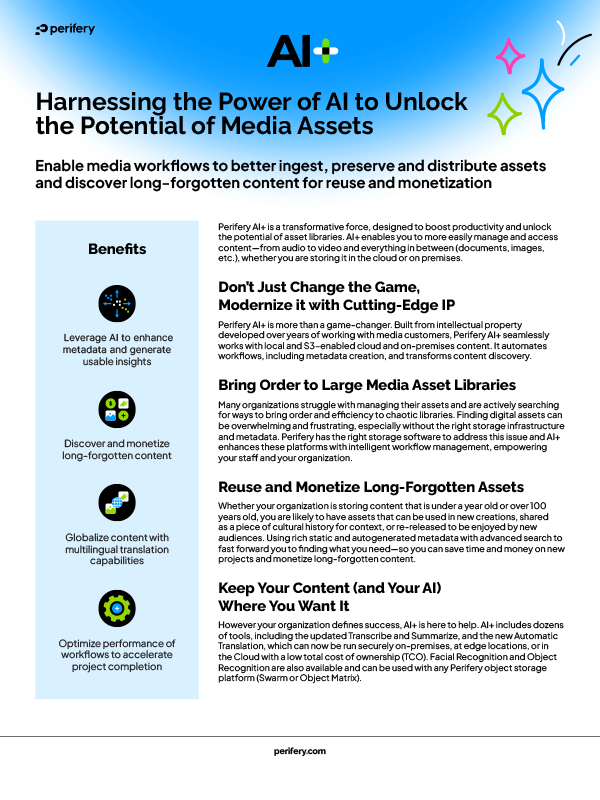
Storytelling is a fundamental aspect in the creative world of media and entertainment. Just as every compelling story requires a rationale - a reason and justification to give it substance and purpose - so do the decisions we make when it comes to media storage partners. In the M&E sector, narratives extend far beyond scripts and screenplays; they shape the decisions that pull together our media workflows. Without logic, these stories serve no purpose. Without logic, we simply waste time, effort, resources, and money.
Don't Believe the Hype
The vast amount of media content being created and consumed is driving the need for technology organizations to stay competitive. Studios, post houses, broadcasters, etc., are always on the lookout for the ‘next big thing’ to enhance their workflows and offer the best content output to viewers. However, this eagerness can lead to decisions being made without proper understanding of the technology. FOMO (fear of missing out) results in impulsive decisions which drive fast adoption. And often, regret.
Who remembers the ‘Great Rush-to-the-Cloud’ of 2020?! Of course, cloud technology had been trickling into our M&E workflows for several years prior, but the global lockdown caused panic, which led to many organizations making decisions which were, to quote my friend Jonathan Morgan, “mis-informed and non-optimal.” A perfect description. So why the mad rush? The simple answer: FOMO.
I’m not denying that the movement to the cloud provided continuity to businesses needing to maintain content accessibility and collaboration across teams. This issue with the mass-move is that, for the most part, it was adopted without evaluation. Cloud solutions promised remote access, scalability, and flexibility, making them the go-to choice when agility was paramount. It gave many organizations a lifeline.
But now we’re on the other side of the pandemic and companies are realizing that cloud-only workflows aren’t the best fit after all. Data privacy concerns, unexpected costs, and the need for tighter control over sensitive information, are driving a 180° shift. Many organizations are now returning to on-premise workflows or introducing hybrid processes that combine the benefits of both cloud and on-prem solutions.
So, what’s the lesson? Decisions made under the influence of FOMO may serve short-term needs but can have long-term repercussions. Don’t fall victim to the pressures of industry hype. Instead, reflect on your business needs, consider your unique requirements, and future-proof your decisions. In short, apply some logic.
The Importance of Logic
Although a simple concept, logic is a critical factor in making informed decisions. It aligns technology choices with your business needs, considering the long-term viability of any new products or solutions. If you like, logic is the rationale of your story. It’s the antidote to the allure of FOMO.
First and foremost, logic should dictate that any new technology or any new workflow process should align with your organization’s aims and objectives. Before folding to external pressures, ask yourself, will this product/solution/process improve our workflows long-term?
I’ve listed some key things to consider when answering the above question:
1. Cost analysis
Am I likely to end up paying for features I won’t use? Are there any additional or hidden costs that I should be aware of?
2. Futureproofing
Can the new product/solution/process adapt as our business needs do? Does it scale easily? Does it have built-in disaster recovery?
3. Support
Will we have reliable, on-going access to a support team for the duration?
4. Sustainability
Is the product/solution/process sustainable long-term? Does it align with our company goals?
It shouldn’t be a split-second decision. You have to consider the potential impact that any changes might have on your organization and workforce. If the answer to the above question is “no”, then move on. If it’s “yes”, you have a justified reason to move forward with the transition. You know your company better than anyone, so any considerations should reflect your individual organizational goals. Remember, if you’re getting no added value, or unlikely to achieve long-term value, then move along.
The Underdogs
The M&E sector is full of cutting-edge technology and providers. It’s a marketplace of innovation. However, it's often the larger companies that dominate. This doesn’t mean they are better; the allure of big names can sometimes overshadow the functionality that smaller, more agile companies bring to the table. Why overpay for a complex solution and only use a fraction of it, when you could have a tailor-made, intuitive one that addresses your specific workflow needs?
I’ve seen so many people get sucked in by the big brand names - and it’s not just the tech sector that is guilty of this – only to be disappointed with the product and/or service. While established brand names have their merits, it's essential to recognize that the allure of a name can sometimes overshadow functionality. The psychological impact of well-known brands can influence buying decisions, often at the expense of the actual merits of the technology. Smaller companies, on the other hand, often rely on their functionality to make a mark in the industry.
Any tech provider that is worth its weight will focus on crafting a customized solution that can evolve over time. And it’s often the underdogs that deliver this personalized approach. They’re the ones that can provide the levels of trust and satisfaction that you’d expect, and they’re the ones that will be with you for the long haul. So, my advice: avoid acting on impulse, explore all the options, and you’ll find the right partner and technology to enhance your workflows. Remember, it's not about the size or the name of the company; it's about finding the tech that does more than look good on paper.
Hint: If you’re looking for a new object storage provider, we’ve got you covered with our five essential steps to finding that perfect partner – Read it here.
Let’s Bring the Excitement Back
Industry hype often clouds judgment, leading organizations to make impulsive decisions that don't align with their true needs. Media companies should take a step back, evaluate the options, and weigh the practicality and real-world benefits of their choices. Informed decisions, rooted in logic, not only save resources but also ensure that your media workflows are aligned with your long-term goals. M&E is a space where imagination meets technology, where boundaries are constantly pushed, and where storytelling comes to life. It's an exciting and creative industry, and the tools and partners we work with should reflect that.
So, before jumping on the bandwagon, remember to apply logic.
